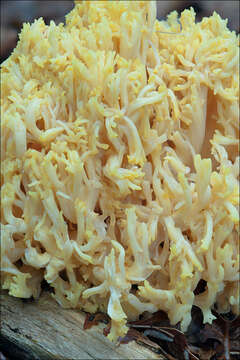Ramaria-flava-var-flava_3

Açıklama:
Ramaria flava var. flava (Schaeff.) Qul., syn.: Clavaria flava Schaeff., Ramaria flavobrunnescens var. aurea (Coker) CornerChangle, DE: Gelbe Koralle, Zitronengelbe Koralle, Schwefelgelbe Koralle, Gelber KorallenpilzSlo.: rumena grivaDat.: Sept. 13. 2017Lat.: 46.36007 Long.: 13.70385Code: Bot_1088/2017_DSC9015Habitat: moderately inclined mountain slope, southeast aspect; Fagus sylvatica forest; calcareous ground; in shade; partly protected from direct rain by tree canopies; elevation 580 m (1.900 feet); average precipitations ~ 3.000 mm/year, average temperature 7-9 deg C, alpine phytogeographical region. Substratum: forest soil covered by thick layer of rotten Fagus sylvatica leaves.Place: Lower Trenta valley, right bank of river Soa; between villages Soa and Trenta; between Trenta 2b cottage and Trenta 2 farmhouse, East Julian Alps, Posoje, Slovenia EC.Comments: Ramaria flava var. flava seems to be a rather common Ramaria in Slovenia But experts believe that often, judged on habitus only, other yellow Ramaria species are misidentified as R. flava. According to Christan (2008), it is mycorrhizal with Fagus sylvatica in contrast to very similar Ramaria flava var. scandinavica = Ramaria obtusissima var. scandinavica Petersen, which is associated with Picea sp. Nevertheless, Index Fungorum does not recognize both names as current names. Two sporocarps found, the larger 14 x 13 cm and 12 cm tall; does not change color when handled, after longer time slowly discolors and gets darker and more ochre; smell lightly acid, on mold; taste mild but specific, lightly nitrous(?), unpleasant; SP abundant, ocher, oac847.Spores almost smooth in profile but shallowly warty. (9,9) 10,4 - 11,6 (11,9) x (3,8) 4,2 - 4,7 (5) microns; Q = (2,2) 2,3 - 2,7 (3); N = 35; Me = 10,9 x 4,4 microns; Qe = 2,5. Basidia dimensions: (38) 41,6 - 52,8 (53,3) x (8,2) 9,1 - 11,1 (12,5) microns; Q = (3,9) 4 - 5 (5,5); N = 18; Me = 46 x 10,2 microns; Qe = 4,5. Hypha with clamps but also simple septa present (this fits to the description in Ref.1). Olympus CH20, NEA 100x/1.25, magnification 1.000 x, oil (spores); NEA 40x/0.65, magnification 400x (basidia), in water, fresh material. AmScope MA500 digital camera.Herbarium: Mycotheca and lichen herbarium (LJU-Li) of Slovenian Forestry Institute, Vena pot 2, Ljubljana, Index Herbariorum LJFRef.: (1) J. Breitenbach, F. Kraenzlin, Eds., Fungi of Switzerland, Vol.2. Verlag Mykologia (1986), p 358. (2) G.J. Krieglsteiner (Hrsg.), Die Grosspilze Baden-Wrttembergs, Band 2., Ulmer (2000), p 75. (3) J. Christan, Die Gattung Ramaria in Deutschland, IHW-Verlag (2008), p 196. (4) S. Buczacki, Collins Fungi Guide, Collins (2012), p 462. (6) R.M. Daehncke, 1200 Pilze in Farbfotos, AT Verlag (2009), p 1033. (7) A. Poler, Veselo po gobe, Mohorjeva druba Celovec (2002) (in Slovenian), p 138. (8) www.biology.sc.chula.ac.th/TNH/archives/v12_no2/3-NIWAT%2... (accessed Sept.18.2017)
Aşağıdaki Sayfalarda Bulunmaktadır:
- Life
- Cellular
- Eukaryota (Ökaryot)
- Opisthokonta
- Nucletmycea
- Fungi
- Dikarya
- Basidiomycota (Bazitli mantarlar)
- Agaricomycetes
- Gomphales
- Gomphaceae
- Ramaria
- Ramaria flava
Bu resim hiçbir koleksiyonda yer almıyor.
Kaynak Bilgileri
- lisans
- cc-by-nc-sa
- telif hakkı
- Amadej Trnkoczy
- fotoğrafçı
- Amadej Trnkoczy
- orijinal
- orijinal medya dosyası
- kaynağı ziyaret et
- ortak site
- Flickr Group
- ID


